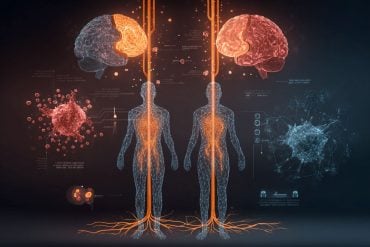Summary: Ginkgo Biloba, a popular herbal supplement, may help in the treatment of Type 2 diabetes. The supplement had a promising effect on beta cells of Langerhans in rat models of the disease. Additionally, Ginkgo Biloba reduced oxidative stress associated with type 2 diabetes.
Source: University of Cincinnati
The extract of the leaves of Ginkgo biloba, a popular dietary supplement, may offer some therapeutic benefits in fighting Type 2 diabetes, according to a study co-authored by a researcher at the University of Cincinnati (UC) College of Medicine.
“In diabetic rats Ginkgo biloba had a very good effect on the beta cells of Langerhans—cells in the pancreas responsible for insulin secretion—by creating a restorative effect similar to what we see in healthy non-diabetic rats,” says Helal Fouad Hetta, PhD, a postdoctoral fellow and scientist in the UC Division of Digestive Diseases. Hetta, shown above, is also on faculty at Egypt’s Assiut University College of Medicine in the Department of Medical Microbiology and Immunology.
The study in animal models by an international team of 13 researchers was published in the journal Diabetes, Metabolic Syndrome and Obesity: Targets and Therapy and is available online. The first author on the research is Ahmed Saleh, PhD, Jazan University in Saudi Arabia. The study demonstrates UC’s committment to research as outlined in the university’s strategic direction Next Lives Here.
“The extracts derived from Ginkgo biloba have been frequently used in traditional medicine and have been shown to exhibit antioxidant potency,” says Hetta. “Magnetized water, which has been passed through a magnetic field, has also been reported to reduce blood glucose, improve antioxidant status and lipid profiles in diabetic rat models.”
In this study, Type 2 Diabetes was induced by feeding rats a high-fat-diet for eight weeks followed by intra-peritoneal injection of a single low dose of streptozotocin, explains Hetta. Forty rats were randomly assigned to four groups: a non-diabetic control group and three diabetic groups. One diabetic group served as a positive control (diabetic), while the other two groups were orally administered with water extract of Ginkgo biloba leaves and magnetized water for four weeks, respectively.
The pancreatic beta cells of diabetic rats are reduced and insulin secretion is curtailed. After having Ginkgo biloba and magnetized water added to their diets, the mass of the pancreatic beta cells and the amount of insulin in these cells was shown to increase markedly, almost back to normal levels, particularly in the Ginkgo biloba-treated group, says Hetta.
In addition, both Ginkgo biloba and magnetized water improved the anti-oxidant status and reduced the oxidative stress associated with type 2 diabetes by down regulation of the two antioxidant enzymes, glutathione and superoxide dismutase 2, in the pancreatic tissue, says Hetta.
These findings for Ginkgo biloba’s impact on Type 2 diabetes are preliminary, says Hetta.

“We still need more evidence about possible benefits for Type 2 diabetes so there is ongoing research,” says Hetta. “Our findings need to be tested in human clinical trials of large sample size.
“Ginkgo biloba is one of the oldest living tree species,” says Hetta. “Most Ginkgo products are made with extract prepared from leaves. Most research on Ginkgo focuses on its effects on dementia and age-related memory impairment such as Alzheimer’s disease and pain caused by too little blood flow or claudication. It is commonly available as an oral tablet, extract, capsule or tea. It is not toxic when used in low dosages, but can interact with other medicines.”
“I would not recommend eating raw or roasted Ginkgo seeds because they can be poisonous,” says Hetta. “It should be taken as a capsule or in tablets if used. Also, if you are currently taking medications please consult with your physicians before considering Ginkgo biloba.”
Collaborators on the study include Ahmed Saleh, Mamdouh Anwar, Ahmed E. Zayed, Gamal Afifi, Emad Shaheen, and Hassien Alnashiri, all from Jazan University in Saudi Arabia. Additional co-collaborators, all from Assiut University in Egypt include Manal El Sayed Ezz Eldeen, Asmaa MS Gomaa, Mahmoud Abd-Elkareem, Alaa Sayed Abou-Elhamd, Ghada Mohamed and Ahmed M. Kotb.
Funding: The work was funded by the Deanship of Scientific Research, Jazan University, Saudi Arabia, Grant # 37/7/00110.
The authors of the study report no conflicts of interest in this work.
Source:
University of Cincinnati
Media Contacts:
Cedric Ricks – University of Cincinnati
Image Source:
The image is in the public domain.
Original Research: Open access
“Impact of Ginkgo biloba extract and magnetized water on the survival rate and functional capabilities of pancreatic β-cells in type 2 diabetic rat model”. Helal Fouad Hetta et al.
Diabetes, Metabolic Syndrome and Obesity: Targets and Therapy. doi:10.2147/DMSO.S209856
Abstract
Impact of Ginkgo biloba extract and magnetized water on the survival rate and functional capabilities of pancreatic β-cells in type 2 diabetic rat model
Introduction: Type 2 diabetes (T2D) is a widely distributed disease that affects large population worldwide. This study aimed to verify the role of Ginkgo biloba (GB) extract and magnetized water (MW) on the survival rate and functional capabilities of pancreatic β-cells in type 2 diabetic rats.
Materials and methods: T2D was induced by feeding the rats on a high-fat diet (20% fat, 45% carbohydrate, 22% protein) for eight weeks followed by intra-peritoneal injection of a single low dose of streptozotocin (25mg/Kg). Forty rats were randomly assigned to four groups (n=10 rats) as follows: non treated control and three diabetic groups. One diabetic group served as a positive control (diabetic), while the other two groups were orally administered with water extract of GB leaves (0.11 g/kg/day) and MW (600 gauss) for four weeks, respectively.
Results: The β-cell mass and insulin expression in these cells increased markedly after both treatments, particularly in GB treated group. In addition, the immune-expression of the two antioxidant enzymes; glutathione and superoxide dismutase 2 (SOD2) in the pancreatic tissue demonstrated a down-regulation in GB and MW treated groups as compared with the diabetic group.
Conclusion: A four-week treatment of GB and MW protected pancreatic β-cell cells and improved their insulin expression and antioxidant status in type 2 diabetic rats.







